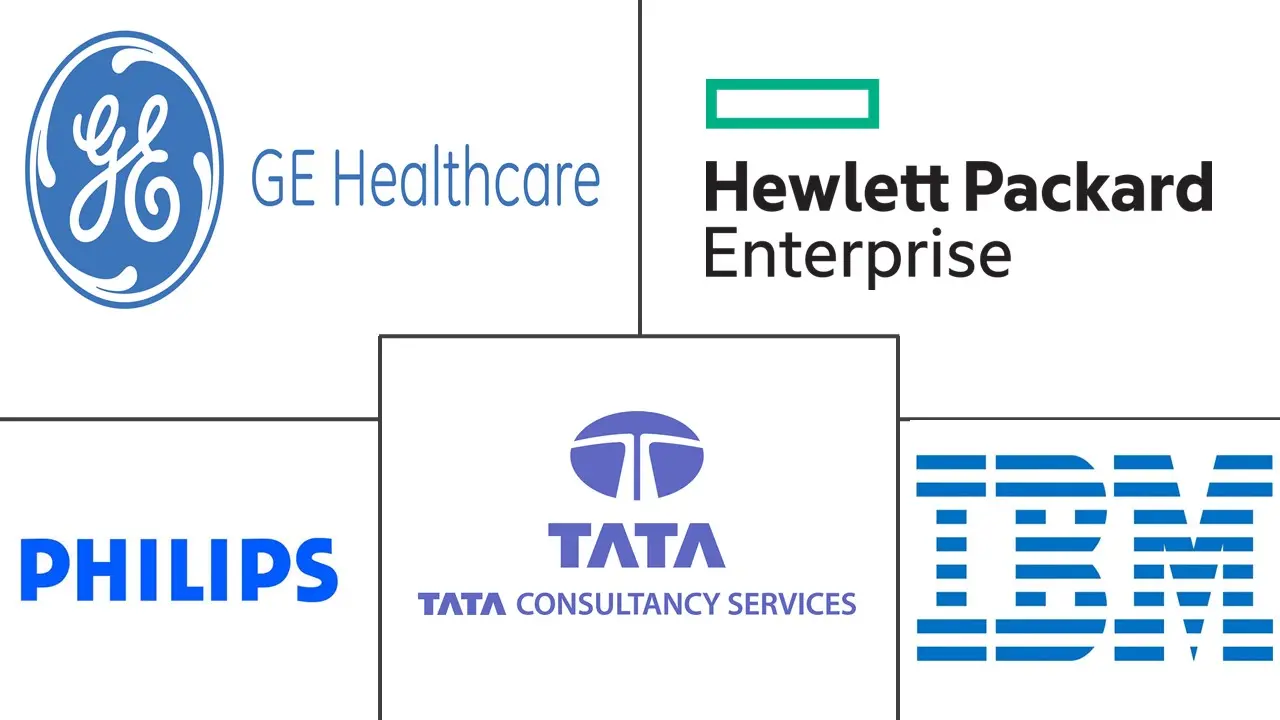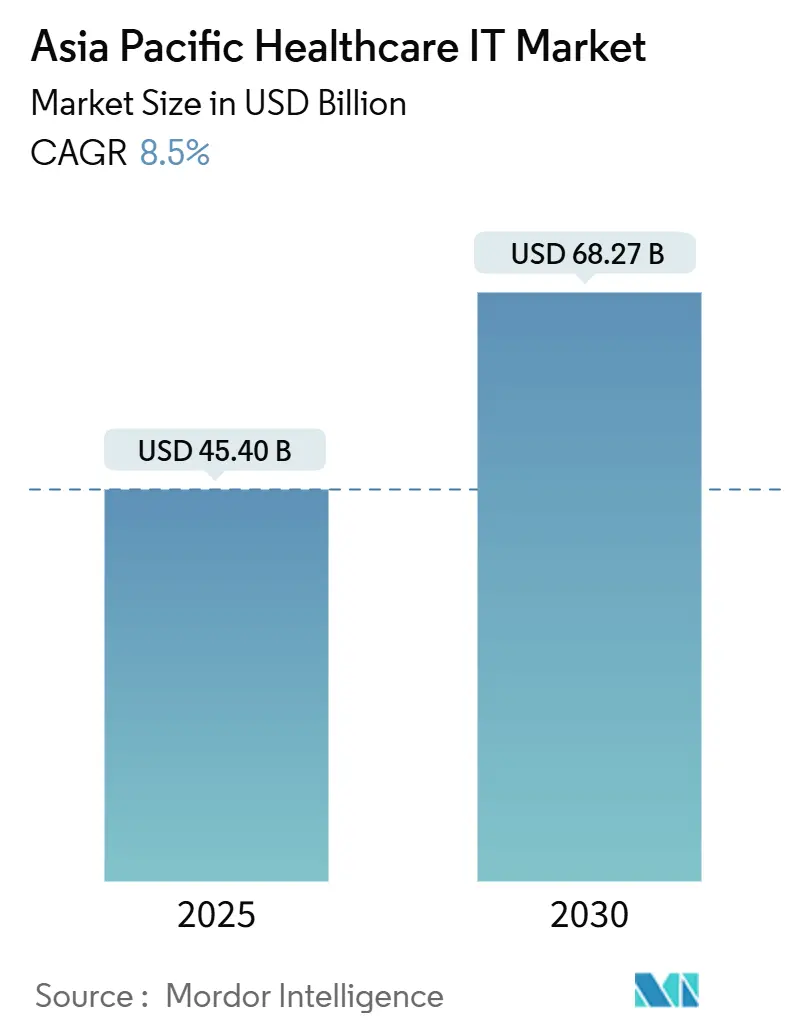
Asia Pacific Healthcare IT Market Analysis by Mordor Intelligence
The Asia Pacific Healthcare IT Market size is estimated at USD 45.40 billion in 2025, and is expected to reach USD 68.27 billion by 2030, at a CAGR of 8.5% during the forecast period (2025-2030).
- Digital technologies are increasingly being adopted across the healthcare sector, propelling the growth of Healthcare IT. Healthcare providers are harnessing IT solutions to enhance patient care, streamline operations, and boost efficiency. This realization has significantly influenced the market's expansion. Furthermore, the surging demand for electronic health records (EHR) and digital health data management systems empowers healthcare professionals to securely access and share patient information. This capability not only fosters better care coordination but also minimizes medical errors, marking it as a pivotal growth driver. Additionally, the escalating need to process and analyze vast amounts of healthcare data is spurring the demand for healthcare analytics and big data solutions.
- The advancement of digital health technologies is driving increased service demand in the healthcare IT market . Governments worldw ide recognize healthcare IT's role in improving patient care, increasing efficiency, and reducing costs. Government initiatives, including incentive programs and funding support, encourage healthcare organizations to adopt electronic health records (EHRs) and other IT solutions. Additionally, the focus on interoperability standards ensures seamless data exchange between healthcare systems and providers, leading to better care coordination, enhanced patient safety, and improved continuity of care. These factors collectively contribute to market growth.
- AI-powered tools enhance radiology, medical imaging, and drug discovery processes. These technologies enable effective remote patient monitoring and telemedicine services. AI systems with natural language processing (NLP) capabilities automate routine administrative tasks in healthcare. NLP systems improve doctor-patient communication while reducing paperwork. AI technology assists in interpreting medical imaging data, including X-rays, CT scans, and MRIs. In December 2024, the All India Institute of Medical Sciences (AIIMS) in New Delhi partnered with Wipro GE Healthcare to establish the AI Health Innovations Hub. This initiative integrates artificial intelligence into cardiology, oncology, and neurology departments to improve patient outcomes.
- Healthcare providers are increasingly drawn to cloud-based solutions due to their scalability and flexibility. These features enable organizations to swiftly adapt their resources in response to fluctuating patient volumes and evolving needs, a necessity in today's fast-paced healthcare environment. Additionally, by adopting cloud solutions, healthcare providers can sidestep the burdens of extensive hardware infrastructure and its associated maintenance, leading to significant cost savings. This financial advantage stands out as a primary driver of the market's expansion. Furthermore, the pay-as-you-go model inherent in cloud services ensures organizations only pay for what they use. This approach not only curtails upfront capital expenditures but also propels the market's growth.
- High maintenance and implementation costs are hindering the growth of the Asia Pacific laboratory information systems (LIS) market. These complex software solutions demand significant capital investment and come with a hefty total cost of ownership. Implementing an LIS entails acquiring specialized hardware, obtaining software licenses, customizing the system to meet a lab's unique needs, and integrating it extensively with existing IT systems. This process can span several months and necessitates teams of experts, engineers, and consultants. As a result, large hospitals and clinical labs face upfront capital costs in the millions, whether installing a new LIS or upgrading an existing one.
Asia Pacific Healthcare IT Market Trends and Insights
Electronic Health Records is Expected to Hold Significant Share of the Market
- Electronic Health Records (EHR) are transforming healthcare by digitizing and centralizing health information. This fosters collaboration among providers, boosts patient engagement, and emphasizes data security, all aimed at delivering efficient, personalized, and high-quality care. In the Asia Pacific, the rising adoption of EHRs reflects their significant impact on healthcare delivery, efficiency, patient outcomes, and adherence to changing regulatory standards. With ongoing technological advancements, the trend of adopting electronic health records is poised to grow even more.
- Government initiatives promoting healthcare IT adoption are fueling this market's expansion. Take, for example, Australia's "My Health Record" – a national digital health platform. Every Australian citizen automatically receives a "My Health Record," unless they opt out. The overseeing agency asserts that , every healthcare provider nationwide will both contribute to and access information on this platform. Additionally, the rollout of cutting-edge healthcare services is poised to further boost the growth of the electronic health record (EHR) market.
- Similarly, in November 2024, in a bid to enhance the exchange of health data between public and private sectors, nine private hospitals in Singapore have pledged to share patient health data with the National Electronic Health Record (NEHR), as announced by the Ministry of Health (MOH). These hospitals are also collaborating with the ministry and Synapxe to prepare their management systems for integration with NEHR, aiming to contribute health information by 2025. All contributors to NEHR must adhere to stringent cybersecurity measures, which encompass regular system updates, staff cybersecurity training, and incident reporting.
- Electronic Health Records (EHR) enhance communication across various healthcare entities, linking hospitals, clinics, and laboratories for a more coordinated patient care approach. By providing a complete view of a patient's medical history, medications, allergies, and test results, EHRs empower healthcare professionals to make informed decisions, thereby minimizing errors and improving care quality. Additionally, EHRs eliminate problems related to illegible handwriting and transcription errors found in paper records.
- Further, according to MHLW (Japan), in January 2024, medical corporations established 5,655 hospitals in Japan, representing roughly 70% of the nation's total hospital count. Electronic Health Records (EHR) empower not just healthcare providers but also patients, granting them access to their health information and nurturing a collaborative bond with their caregivers. By adopting Electronic Health Records (EHR), healthcare organizations align with shifting global regulations and standards, bolstering data security and privacy, and positioning themselves to meet industry mandates.
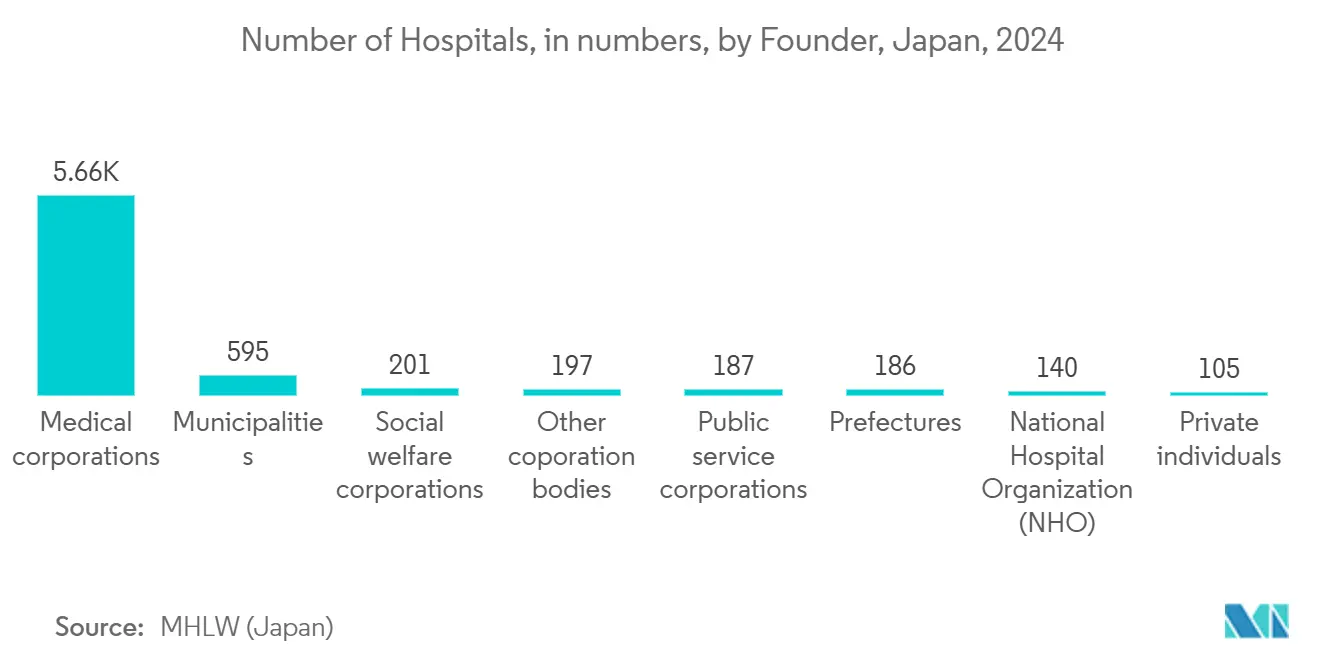
China is Expected to Hold a Significant Market Share
- In China, artificial intelligence (AI) and big data are transforming healthcare delivery. AI accelerates drug development by swiftly identifying potential compounds and refining clinical trials. Furthering its commitment to modernizing traditional practices, China has inaugurated the CR-BU Joint Innovation Center on Smart Chinese Medicine. This center, a collaboration between Hong Kong Baptist University and the China Resources Research Institute of Science and Technology, aims to pioneer a chronic disease management system and delve into AI and big data applications in Chinese medicine.
- This initiative dovetails with the Chinese government's push for smart hospital constructions and heightened R&D investments, particularly in AI. The joint endeavor aspires to both standardize and globalize smart Chinese medicine, marking a significant step in the evolution of traditional Chinese practices.
- Medical institutions must adhere to the Administrative Regulations on Telemedicine Services, covering personnel, equipment, service processes, and management responsibilities. Software as a Medical Device (“SaMD”) will be regulated under the Medical Devices Regulations, Rules for Classification, and Guiding Principles for AI Medical Software Products. Clinical Decision Support Software (“CDSS”) is primarily used for drug allergy warnings, clinical guidelines, drug dosing support, and remote patient monitoring. While CDSS systems are in use at Chinese medical institutions, challenges persist, including the absence of access standards and industry regulations for CDSS products.
- Software-based cardiovascular information systems (CVIS) collect and manage clinical data. Designed for clinical researchers, physicians, nurses, and chemists, these systems streamline clinical workflows and integrate data seamlessly. With the rise of telemedicine and the advent of advanced technological products, the CVIS market is poised for significant growth. Compared to traditional data management methods, CVIS enhances efficiency for cardiac surgeons and hospital administrators alike. As reported by the National Institute of Health, China is home to approximately 330 million individuals currently battling cardiovascular diseases (CVD). This figure encompasses 13 million suffering from strokes, 11.39 million with coronary heart disease.
- Radiology departments are increasingly turning to integrated Radiology Information Systems (RIS) that merge with Picture Archiving and Communication Systems (PACS). This unified solution streamlines image and data management, minimizing manual coordination and boosting workflow efficiency. As Electronic Health Record (EHR) platforms and digital imaging gain traction, the demand for integrated systems to oversee clinical workflows throughout medical facilities has surged. By adopting integrated RIS solutions, healthcare staff can focus more on patient care, leading to fewer errors and enhanced inter-departmental communication. This has made such systems immensely popular in the healthcare sector.
- Healthcare IT systems respond directly to mortality rates, which drive the demand for efficient data management and analytics. When mortality rates rise, there's an increased urgency for enhanced patient monitoring, predictive analytics, and timely interventions. As a result, healthcare IT solutions are honing in on improving data accuracy, decision-making, and clinical outcomes. This focus also accelerates the adoption of telemedicine and remote monitoring, tackling challenges in healthcare delivery.
- Furthermore, trends in mortality shape healthcare policies and resource distribution, subsequently influencing the requirements for IT infrastructure. In essence, healthcare IT evolves to bolster patient care and strategies aimed at reducing mortality. accoridng to National Bureau of Statistics of China, n 2024, the mortality rate in China ranged at approximately 7.76 deaths per 1,000 inhabitants.
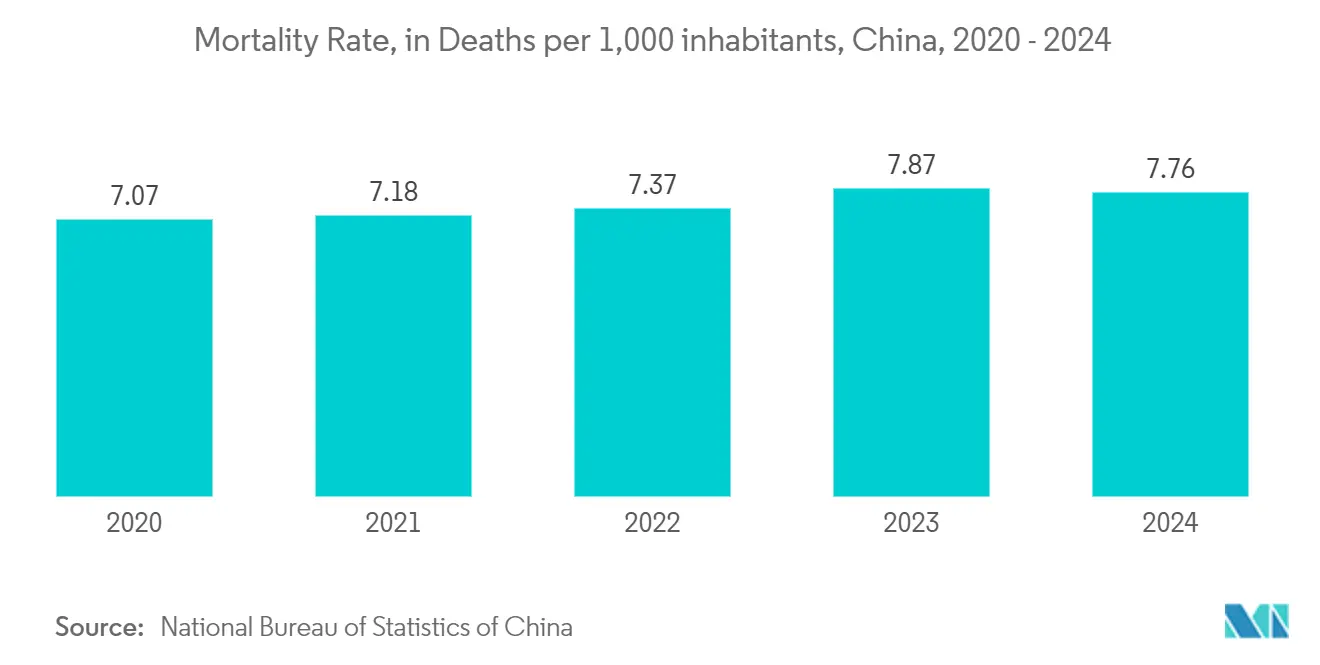
Competitive Landscape
The studied market is semi consolidatded. Driven by rising healthcare demands and a push for digital transformation, the APAC healthcare IT market is witnessing rapid growth. Both government and private sectors are pouring investments into technologies, including electronic health records (EHR), telemedicine, and AI-driven diagnostics. Key players in the market are Philips, IBM Corporation, GE Healthcare, and others.
Given the region's vast and varied population, there's a pressing need for scalable and interoperable IT solutions. The swift adoption of cloud computing is enhancing data management and healthcare delivery. However, challenges remain, including data security issues, privacy concerns, and a lack of skilled professionals. Yet, with notable strides in AI, IoT, and healthcare automation, APAC is set to emerge.
Asia Pacific Healthcare IT Industry Leaders
Philips
IBM Corporation
GE Healthcare
Hewlett-Packard
Tata Consultancy Services
- *Disclaimer: Major Players sorted in no particular order
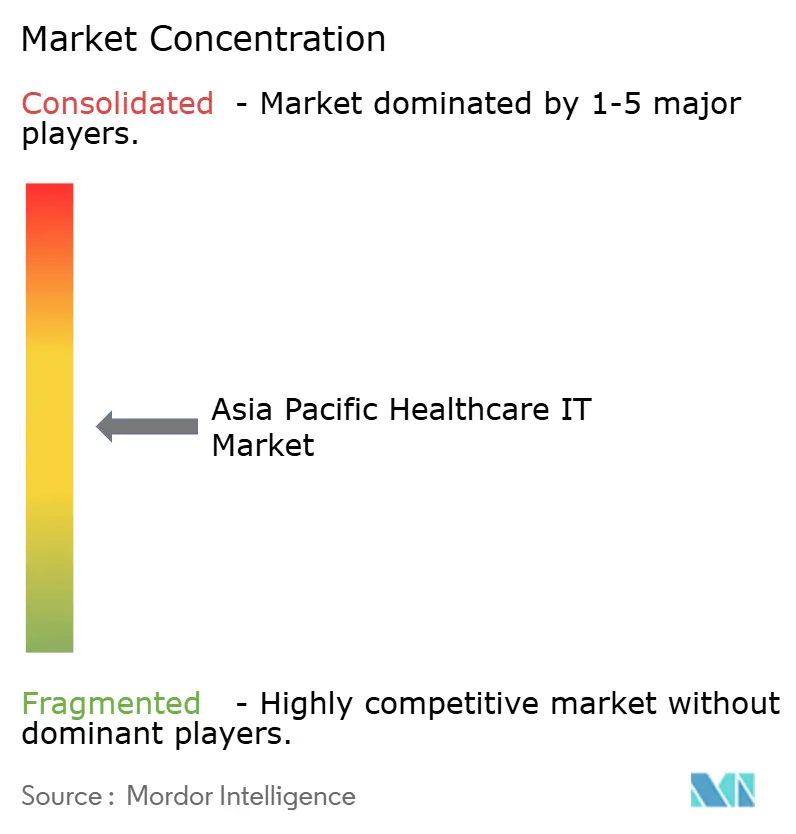
Recent Industry Developments
- January 2025: In a move to bolster health management for its users, Samsung has teamed up with health tech firm Eka Care. This collaboration brings the "Health Records" feature to the Samsung Health app. With this new feature, users can directly access and create their Ayushman Bharat Health Account (ABHA) within the Samsung Health Mobile App. This integration allows users to oversee their health data from healthcare providers across India. Samsung's initiative not only empowers its users but also aligns seamlessly with the Indian government's Ayushman Bharat Digital Mission (ABDM) project, emphasizing a secure integration with the nation's digital health framework.
- December 2024: Fangzhou Inc, a key player in internet healthcare solutions, has forged a strategic alliance with Bristol Myers Squibb (BMS). The collaboration was solidified when Fangzhou's founder, chairman, and CEO, alongside the head of BMS's Innovative Medicines Division in China and the General Manager for BMS in Hong Kong, inked the agreement. This partnership seeks to spearhead advancements in internet healthcare, focusing on pioneering digital medical platforms and innovative models for managing chronic diseases online.
Asia Pacific Healthcare IT Market Report Scope
Healthcare IT, or healthcare information technology, refers to the multitude of technology tools used by physicians, nurses, health administrators, patients, insurance companies, government entities, and others to compile, store, analyze, and share health information. Health IT tools include electronic health records (EHR), personal health records, electronic prescription services, health-related smartphone apps, and more.
APAC Healthcare IT Market is segmented by solution (laboratory information systems (LIS), picture archiving and communication systems (PACS) and vendor neutral archive (VNA), radiology information systems (RIS), cardiovascular information system (CVIS), electronic health records (EHR), telehealth and telemedicine, clinical decision support system (CDSS), claims management solutions, fraud analytics, billing and accounts management services), end users (payers, providers), and country (China, Japan, India, South Korea, Rest of APAC). The market sizes and forecasts are provided in terms of value (USD) for all the above segments.
| Laboratory Information Systems (LIS) |
| Picture Archiving and Communication System (PACS) and Vendor Neutral Archive (VNA) |
| Radiology Information Systems (RIS) |
| Cardiovascular Information System (CVIS) |
| Electronic Health Records (EHR) |
| Telehealth and Telemedicine |
| Clinical Decision Support System (CDSS) |
| Claims Management Solutions |
| Fraud Analytics |
| Billing and Accounts Management Services |
| Other Business Segments |
| Payers |
| Providers |
| China |
| South Korea |
| Japan |
| India |
| Rest of APAC |
| Solution | Laboratory Information Systems (LIS) |
| Picture Archiving and Communication System (PACS) and Vendor Neutral Archive (VNA) | |
| Radiology Information Systems (RIS) | |
| Cardiovascular Information System (CVIS) | |
| Electronic Health Records (EHR) | |
| Telehealth and Telemedicine | |
| Clinical Decision Support System (CDSS) | |
| Claims Management Solutions | |
| Fraud Analytics | |
| Billing and Accounts Management Services | |
| Other Business Segments | |
| End Users | Payers |
| Providers | |
| Country | China |
| South Korea | |
| Japan | |
| India | |
| Rest of APAC |
Key Questions Answered in the Report
How big is the Asia Pacific Healthcare IT Market?
The Asia Pacific Healthcare IT Market size is expected to reach USD 45.40 billion in 2025 and grow at a CAGR of 8.5% to reach USD 68.27 billion by 2030.
What is the current Asia Pacific Healthcare IT Market size?
In 2025, the Asia Pacific Healthcare IT Market size is expected to reach USD 45.40 billion.
Who are the key players in Asia Pacific Healthcare IT Market?
Philips, IBM Corporation, GE Healthcare, Hewlett-Packard and Tata Consultancy Services are the major companies operating in the Asia Pacific Healthcare IT Market.
What years does this Asia Pacific Healthcare IT Market cover, and what was the market size in 2024?
In 2024, the Asia Pacific Healthcare IT Market size was estimated at USD 41.54 billion. The report covers the Asia Pacific Healthcare IT Market historical market size for years: 2019, 2020, 2021, 2022, 2023 and 2024. The report also forecasts the Asia Pacific Healthcare IT Market size for years: 2025, 2026, 2027, 2028, 2029 and 2030.
Page last updated on:
Asia Pacific Healthcare IT Market Report
Statistics for the 2025 Asia Pacific Healthcare IT market share, size and revenue growth rate, created by Mordor Intelligence™ Industry Reports. Asia Pacific Healthcare IT analysis includes a market forecast outlook for 2025 to 2030 and historical overview. Get a sample of this industry analysis as a free report PDF download.
